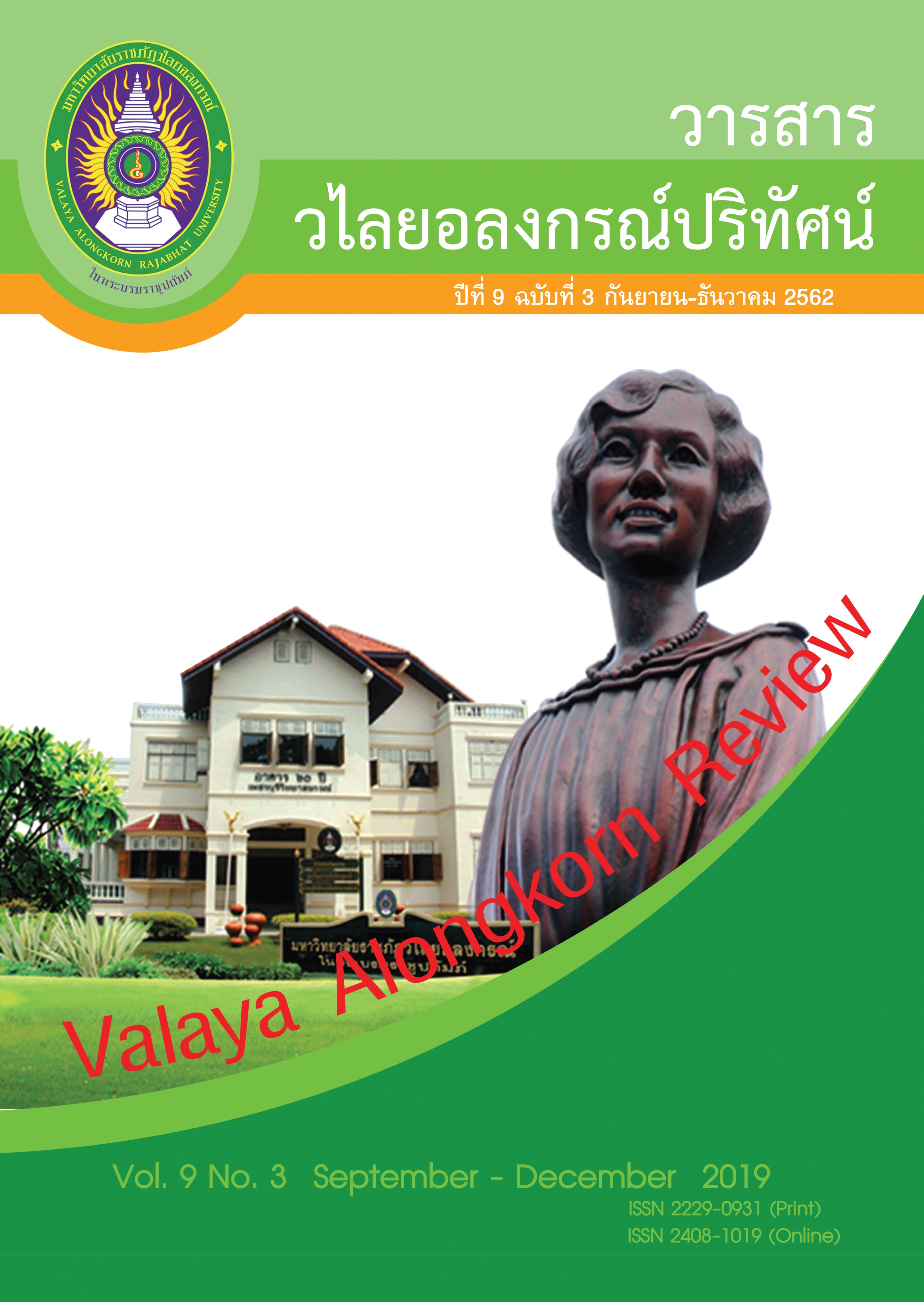กลยุทธ์สื่อสารภาษาอังกฤษของนักศึกษาระดับปริญญาตรี ที่เรียนรายวิชากลยุทธ์การฟัง-พูดสำหรับผู้เรียนภาษาอังกฤษ เป็นภาษาต่างประเทศ
คำสำคัญ:
กลยุทธ์สื่อสารภาษาอังกฤษ, ทักษะการฟัง-พูดภาษาอังกฤษ, นักศึกษาระดับปริญญาตรีบทคัดย่อ
การศึกษานี้มีวัตถุประสงค์เพื่อ 1) ศึกษาการใช้กลยุทธ์สื่อสารภาษาอังกฤษ และ 2) เปรียบเทียบการใช้กลยุทธ์สื่อสารภาษาอังกฤษระหว่างนักศึกษาชายและนักศึกษาหญิง ที่เรียนรายวิชากลยุทธ์การฟัง-พูดภาษาอังกฤษ งานวิจัยนี้เก็บข้อมูลการใช้กลยุทธ์สื่อสารภาษาอังกฤษ ของนักศึกษาระดับปริญญาตรี มหาวิทยาลัยราชภัฎวไลยอลงกรณ์ ในพระบรมราชูปถัมภ์ จังหวัดปทุมธานี จากกลุ่มตัวอย่าง จำนวน 122 คน ที่ลงทะเบียนเรียนรายวิชากลยุทธ์การฟัง-พูดสำหรับผู้เรียนภาษาอังกฤษเป็นภาษาต่างประเทศ (VLE210) ในภาคการศึกษาที่ 1 ปีการศึกษา 2562 การเก็บรวบรวมข้อมูลเชิงปริมาณ โดยใช้แบบสอบถามการใช้กลยุทธ์สื่อสารภาษาอังกฤษ (Oral Communication Strategy Inventory) มีค่าความเชื่อมั่น เท่ากับ 0.89 และเก็บข้อมูลเชิงคุณภาพจากการสัมภาษณ์และการสังเกตการณ์แบบมีส่วนร่วม การวิเคราะห์ข้อมูลเชิงปริมาณใช้สถิติ เชิงพรรณนา ได้แก่ การแจกแจงความถี่ ร้อยละ ค่าเฉลี่ย ส่วนเบี่ยงเบนมาตรฐาน และสถิติเชิงอนุมาน คือ การทดสอบ Independent t-test ส่วนข้อมูลเชิงคุณภาพใช้เทคนิคการวิเคราะห์เนื้อหา
ผลการวิจัยพบว่า นักศึกษาใช้กลยุทธ์สื่อสารภาษาอังกฤษในระดับปานกลางถึงมาก เมื่อเปรียบเทียบการใช้กลยุทธ์สื่อสารพบว่า นักศึกษาชายและหญิงใช้กลยุทธ์สื่อสารแตกต่างกันอย่างมีนัยสำคัญ (p < 0.05) นักศึกษาชายใช้กลยุทธ์การแก้ปัญหาทักษะฟังในระดับมาก (ค่าเฉลี่ย 3.62) และใช้กลยุทธ์การแก้ปัญหาทักษะการพูดในระดับปานกลาง (ค่าเฉลี่ย 3.39) โดยนักศึกษาชายใช้ กลยุทธ์การเจรจาเพื่อเข้าใจความหมายขณะฟังสูงที่สุด (ค่าเฉลี่ย 3.98) และใช้กลยุทธ์การพยายามคิดเป็นภาษาอังกฤษต่ำที่สุด (ค่าเฉลี่ย 2.89) ส่วนนักศึกษาหญิงใช้กลยุทธ์การแก้ปัญหาทักษะฟังในระดับมาก (ค่าเฉลี่ย 3.54) และใช้กลยุทธ์การแก้ปัญหาทักษะการพูดในระดับปานกลาง (ค่าเฉลี่ย 3.44) เช่นกัน โดยนักศึกษาหญิงใช้กลยุทธ์เชิงอารมณ์และสังคมสูงที่สุด (ค่าเฉลี่ย 3.97) และใช้กลยุทธ์การพยายามคิดเป็นภาษาอังกฤษต่ำที่สุด (ค่าเฉลี่ย 2.95) ผลการวิจัยนี้จะเป็นประโยชน์ต่อการพัฒนาหลักสูตรรายวิชาภาษาอังกฤษ VLE210 ให้สอดคล้องกับความสนใจและความต้องการจำเป็นของผู้เรียนในการพัฒนาทักษะการฟัง-พูดภาษาอังกฤษให้ดียิ่งขึ้น และเสนอแนะว่าหลักสูตรวิชาภาษาอังกฤษควรสอดแทรกการสอนกลยุทธ์สื่อสารให้กับผู้เรียน เพื่อให้ผู้เรียนสามารถเลือกใช้กลยุทธ์สื่อสารที่เหมาะสมกับบริบทสนทนา และนำทักษะความรู้ภาษาอังกฤษไปใช้ในสถานการณ์สื่อสารจริงได้อย่างมีประสิทธิภาพ
เอกสารอ้างอิง
จักรี บุญญเมธี และเพ็ญพิสาข์ ศรีวรนารถ. (2561). กลวิธีการสื่อสารในการพูดภาษาสเปนของผู้เรียนชาวไทย. วารสารมนุษยศาสตร์. 25(2): 209-231.
ทรงศรี สรณสถาพร และศักดิ์ชัย โพธิ์ศัย. (2561). ผลการเรียนรู้และกลยุทธ์ในการสื่อสารภาษาอังกฤษด้วยการเรียนรู้แบบใช้โครงงานเป็นฐานเพื่อพัฒนาทักษะการสื่อสารภาษาอังกฤษของผู้เรียนระดับอุดมศึกษา. วารสารวิชาการมหาวิทยาลัยธนบุรี. 9(1): 282-293.
ธนกร สุวรรณพฤฒิ. (2558). “การพัฒนารูปแบบการสอนกลยุทธ์การเรียนภาษาต่างประเทศเพื่อเสริมสร้างความสามารถในการฟังและการพูดภาษาอังกฤษสำหรับนักศึกษาระดับปริญญาตรี.” วิทยานิพนธ์ปรัชญาดุษฎีบัณฑิต สาขาวิชาหลักสูตรและการสอน บัณฑิตวิทยาลัย มหาวิทยาลัยศิลปากร.
ศักดิ์ชัย โพธิ์ศัย และทรงศรี สรณสถาพร. (2561). กลยุทธ์ในการสื่อสารของนักศึกษาไทยสาขาวิชาเอกภาษาจีน: ความแตกต่างระหว่างภาษาอังกฤษและภาษาจีน. วารสารมนุษยศาสตร์ปริทรรศน์. 40(1): 94-103.
Ali, O. H. (2016). Gender Differences in Using Language in the EFL Classes: From Teachers’ Views. International Journal of Humanities and Cultural Studies. 2(4), 73-91.
Allwright, D. (1990). Autonomy in Language Pedagogy. CRILE Working Paper 6. Centre for Research in Education, University of Lancaster, U.K.
Amin, Y. M. (2017). Communication Strategies and Gender Differences; A Case Study. International Journal of Humanities and Cultural Studies. 4(3), 226-238.
Bialystok, E. (1990). Communication Strategies. Oxford: Blackwell.
Canale, M. & Swain, M. (1980). Theoretical Bases of Communicative Approaches to Second Language Teaching and Testing. Applied Linguistics, 1, 1-47.
Dornyei, Z. (1995). On the Teach ability of Communication Strategies. TESOL Quarterly. 29, 55-85.
Dumrongkiat, M. (2018). Thai English Proficiency Drops. Bangkok Post, [Online], Available: https://www.bangkokpost.com/thailand/general/1570042/thai-english-proficiency-drops/Education First. (2019). EF English Proficiency Index, Retrieved from http://www.ef.co.th/epi/regions/asia/thailand/
Harmer, J. (2007). The Practice of English Language Teaching. Harlow: Longman.
Huang, C. P. (2010). Exploring Factors Affecting the Use of Oral Communication Strategies. Long Hua Technology University Journal. 30, 85-104.
Kongsom, T. (2009). The Effects of Teaching Communication Strategies on Thai Learners of English. University of Southampton, School of Education, Doctoral Thesis, 363 pp.
Lai, H. (2010). Gender Effect on the Use of Communication Strategies. English Language Teaching. 3(4), 28-32.
Lin, Y. (2003). Interphonology Variability: Sociolinguistic Factors Affecting L2 Simplification Strategies. Oxford: Oxford University Press.
Little, D. (1991). Learner Autonomy: Definitions, Issues and Problems. Dublin: Authentik.
Marzec-Stawiarska, M. (2015). Investigating Foreign Language Speaking Anxiety Among Advanced Learners of English. In: Pawlak M., Waniek-Klimczak E. (eds) Issues in Teaching, Learning and Testing Speaking in a Second Language. Second Language Learning and Teaching. Springer, Berlin, Heidelberg
Micharet, L. (2015). Factors Affecting Second Language Communication Strategies Use and Development. Universitat De Barcelona, Doctoral Thesis, 240 pp.
Nakatani, Y. (2005). The Effects of Awareness-Raising Training on Oral Communication Strategy Use. The Modern Language Journal. 89(1), 76-91.
Nakatani, Y. (2006). Developing an Oral Communication Strategy Inventory. The Modern Language Journal. 90(2), 151–168.
Nakatani, Y. (2010). Identify Strategies that Facilitate EFL Learners’ Oral Communication: A Classroom Study Using Multiple Data Collection Procedures. The Modern Language Journal. 94, 116-136.
Oxford, R. L. (1990). Language Learning Strategies: What Every Teacher Should Know. Boston: Heinle & Heinle.
Richards, J. C. (2006). Communicative Language Teaching Today. Cambridge, UK: Cambridge University Press.
Tarone, E. (1980). Communication Strategies, Foreigner Talks, and Repair in Interlanguage. Language Learning: A Journal of Research in Language Studies. 30(2), 417-428.
Wongsawang, P. (2001). Cultural-Specific Notions in L2 Communication Strategies. Second Language Studies. 19(2), 111-135.
ดาวน์โหลด
เผยแพร่แล้ว
รูปแบบการอ้างอิง
ฉบับ
ประเภทบทความ
สัญญาอนุญาต
ข้อความที่ปรากฏในบทความแต่ละเรื่องในวารสารวไลยอลงกรณ์ปริทัศน์ เป็นความคิดเห็นของผู้นิพนธ์แต่ละท่าน มิใช่เป็นทัศนะและมิใช่ความรับผิดชอบของกองบรรณาธิการจัดทำวารสาร และ
มหาวิทยาลัยราชภัฏวไลยอลงกรณ์ ในพระบรมราชูปถัมภ์


